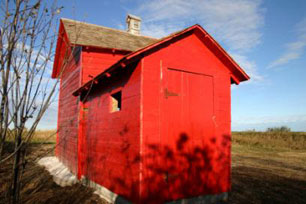|
SYDNEY
FYSON CAME TO HARTNEY from Boissevain in 1904 and was connected with
meat marketing. He had a butcher shop and was connected in buying furs
and cattle hides for shipment, and in hunting foxes and wolves for
their hides. He was a tall rangy Englishman and when, with a perpetual
cigar in his mouth he drove through the streets or along the country
road in a democrat drawn by a team of equally rangy roan horses,
followed by a pack of lean hounds, he presented a sight not easily
forgotten.
When he ceased to own a butcher shop, Syd Fyson became the butcher for
the beef-rings set up in the rural districts. A beef-ring was a
combination of neighbouring farmers who took turns in contributing a
well-fed cow or steer to be butchered each week to provide beef for the
members of the ring. The districts around Hartney chose different days
of the week for butchering their beef and Sid Fyson drove to each in
turn to prepare the roasts, steaks and lesser cuts for the customers
whose turn it was to receive each. Through this contact with the farm
people Syd became well known and liked by the entire community. When
the use of horses was discontinued, Syd, sitting erect and tall at the
wheel of an uncovered Ford car, a cigar still in his mouth and a hound
or two riding in the car’s rear seat, continued to attract attention.
Adapted from The Mere
Living, page 175.
A
Beef Ring Building

Essentially a small slaughterhouse, this structure in Gilbert Plains,
completed in 1923, facilitated the co-operative efforts of a rural
community to ensure a supply of fresh beef in times before refrigerated
storage was available. Each week during the summer a member of the Beef
Ring supplied a steer to be kept overnight in the holding stall, killed
and butchered in the compact but ingeniously equipped main room and
then shared. The utilitarian building thus belies its internal
inventiveness: like the inclusion of a holding stall separate from the
killing floor, the large wooden built-in hoist for lifting the carcass,
a metal ring embedded in the concrete floor to secure the animal before
slaughter, and the row of large nails along two walls, each numbered,
where the members’ portions of beef were placed in sugar sacks.
|





